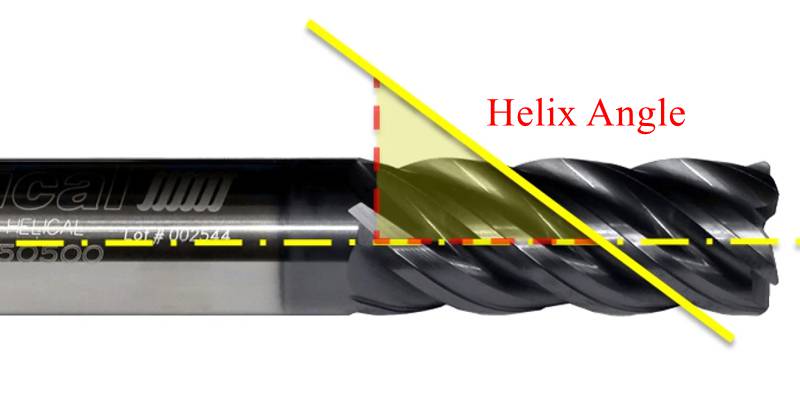- October 21, 2022
There are many factors that impact the quality and performance of a machining application. Often, the helix angle is overlooked. It is a simple geometric feature in helical end mills and other cutting tools. This factor can influence chip control, vibration, power requirements, etc.
In this article, we will discuss what a helix is in the context of machining, its benefits and drawbacks, and what helix angle solutions are ideal for your applications.
What is a Helix?
A helix, quite simply put, is a smooth 3D curve that spirals around a linear axis. A simple way to understand it is to imagine a helical spring, whose coils represent a helix curve.
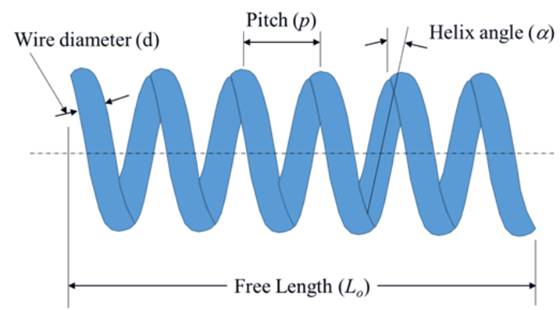
Main Geometric Features of a Helix
Four main features of a helix fully define its shape:
Central Axis: As explained above, a helix is always centered on an axis. It provides a reference for locating and orienting the helix in a 3D space.
Helix Angle: As seen in the figure, the coils of the spring are at an angle from the axis, known as the angle of the helix.
Pitch: The distance between two successive turns of the helix is its pitch. A larger pitch means a ‘longer’ helix. This is an important value when designing different types of threads, linking their linear movement to rotational motion.
Number of Turns: This is an important parameter in defining the total length of a helical curve. The more the turns, the longer the helix.
What is Helix Angle in Cutting Tools?
Several cutting tools have helical flutes (cutting edges), the most common ones being helical end mills and helical drills. The image below shows the helix on a cutting tool. The same logic as explained above applies here – the angle of the cutting edges corresponds to the helix angle of the tool.
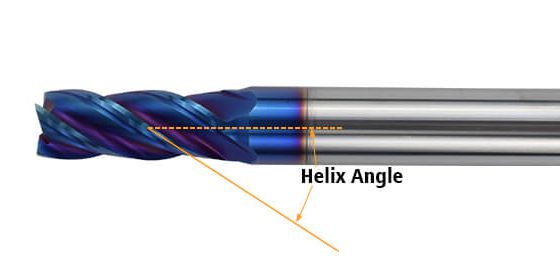
The angle of the helix for end mills varies between 12°-60°, depending upon the application. Typically, however, a 30°-40° angle is recommended for most jobs. This range offers a good balance between all factors involved.
Small variations in this angle can change the performance of a cutting tool. Hence, manufacturing engineers and operators must be knowledgeable about its various effects. Let’s dive into the details of how different helix angles affect machining performance.
High Helix Angles vs. Low Helix Angles Cutting Tool: What are Differences?
The helix angle can be either fast (high) or slow (low). Generally, experts consider the transition from low to high helix at around 40°. It affects important factors like cutting forces, material removal rate, surface finish, and chip evacuation.
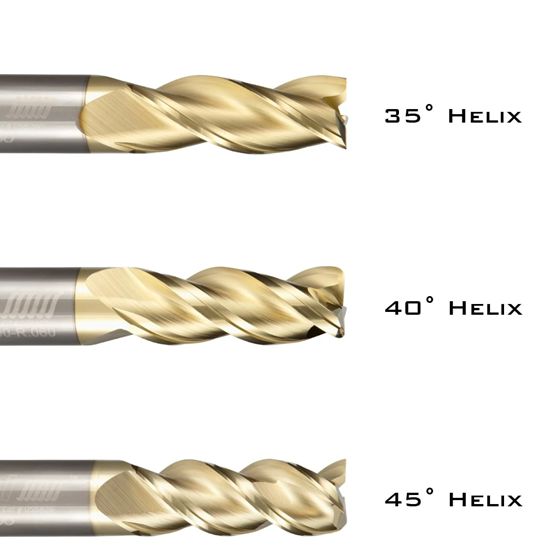
High Helix Angle Tools
A cutter with a high angle of helix is great for high-feed machining, surface finish, and thermal performance.
Its highly inclined teeth enter the cut gradually. As a result, the forces on the tool increase gradually as well, prolonging its life. Moreover, due to their inclination, multiple flutes are in the cut simultaneously, further decreasing the load on individual flutes.
The helix diverts a portion of the radial force up the z-axis of the CNC machine. Since the tool is held rigidly in this direction by the tool holder and spindle, it has a positive effect on tool life and machining tolerance. Owing to this decreased radial force, the tool can cut at higher feed rates. The low radial force also decreases tool deflections and improves surface finish.
In terms of chip evacuation, a high helix tool performs quite well. The force in the z-axis (axial force) pushes the chips out of the cutting zone, quite like a drill bit or tapping. This is good for heat removal and reduces material build-up. However, the same force might also sometimes pull the workpiece upwards and disturb its mounting consequently. This is, however, avoidable though with proper mounting.
Low Helix Angle Tools
Helical end mills with low helix angles have their own set of advantages. They have strong cores and cutting edges, giving them the capacity to withstand higher stresses. If high material removal rate is the goal, these tools are preferable as they scoop out larger, continuous chips. They are more suitable for hard materials as well.
However, the downside to such tooling is that the user has to compromise surface quality with low helix cutters.
How to Choose Helix Angle for Your Application?
An expert engineer/machinist knows which tools are best for their specific applications. The angle of the helix should be an important consideration when choosing a tool for a job.
We will highlight some situations where knowledge of the helix angle can help in decision-making.
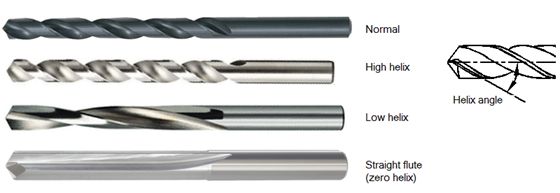
1. Productivity Requirements
The effects of the helix on the material removal rate are already discussed. A lower helix angle is preferable if a lot of material needs to be removed quickly.
This can be coupled with compensatory measures to reduce the negative effects of a low helix. For example, a high helix tool can be used for the finishing pass and a low helix for rough cuts.
2. Pocketing
When milling pockets, efficient chip management is very important. Chips that remain in the cutting zone can be highly detrimental to the tool and part quality. A high helix improves chip evacuation and is consequently suitable for pocketing/slotting-type jobs.
3. Thin Walls/Floors
Thin wall structures and thin floors deform very easily under cutting forces. For walls, the radial forces cause deformation, and for floors, the axial force matters.
Since the angle of the helix directly affects both these force components, machinists can make an informed decision for an appropriate tooling solution. For example, when machining a thin wall, they may consider shifting to a high helix cutter to minimize radial forces and get a fine finish.
4. Tool Life
One downside of having high helix flutes is that the thickness of the center (core) of the cutter is reduced. This deteriorates the tool’s core strength, and thus, tool life.
However, a low helix is not the best for tool life either. It causes problems in the form of heat accumulation and impact loading due to interrupted cuts. Material buildup on the cutting edges is also possible due to poor chip evacuation.
Different Helix Angles for Cutting Various Materials
Different materials require different helix angles. For example, hard metals require low helix angles for successful results, while high helix angles are best for soft metals. Therefore, the type of material being milled should be taken into consideration when selecting the appropriate helix angle.
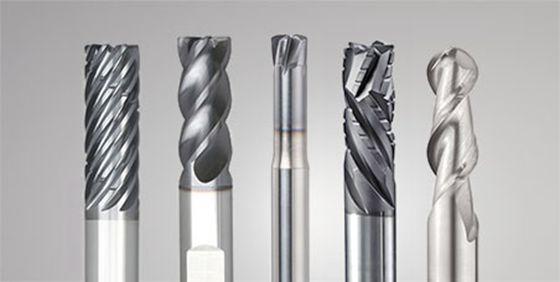
Low helix angle tools are well-suited for short chipping and hard metal materials. These include steel, cast irons, and easy-machining stainless steel. Additionally, synthetic material types like epoxy-based synthetics, fiberglass sheets, and abrasive plastics also are better machined with low helix tooling.
However, cutters with a high angle of the helix are good for softer, materials like aluminum, copper, plastics, etc.
In addition, a variable helix angle cutter is the ideal choice for high-performance machining. It is suitable for difficult-to-machine materials such as stainless steel and heat-resistant superalloys. Their superior cutting performance and extended tool life, make them the perfect choice for even the most challenging machining applications.
Conclusion
We hope that this was an interesting article for our readership. There are many variables in machining and the helix angle is not discussed enough in proportion to its significance. An expert knows all aspects of his trade and optimizes performance with this knowledge and experience.
WayKen Rapid Manufacturing is an industry-leading provider of CNC machining services. Our manufacturing experts are well-versed in modern machining technologies and utilize the most optimal tooling and equipment to deliver high-quality machined parts with tight tolerances.
Feel free to contact us for your rapid manufacturing needs. With our unbeaten expertise, you can expect nothing less than the best!
FAQs
What’s the difference between a lead angle and a helix angle?
The lead and helix angles are complementary (their sum is 90 degrees). They share one reference line, which is tangent to the helix of the thread or gear. The other reference line, however, is different. For the helix angle, it is the axis of the helix under consideration. For the lead angle, the second reference line is the line perpendicular to the helix’s central axis.
What is the use of variable helix endmills for helix angle?
Variable helix end mills are special cutters with different helix angles for each flute. They have high dynamic stability as they are capable of damping vibrations at resonant frequencies of the tool. As a result, these tools experience less chatter and produce a finer surface finish.
Why helix angles are important in machining?
The helix angle is a core geometric parameter of machining cutters. It is important as it affects the material removal rate, feed rate, surface finish, cutting force distribution, tool strength, and tool life.

